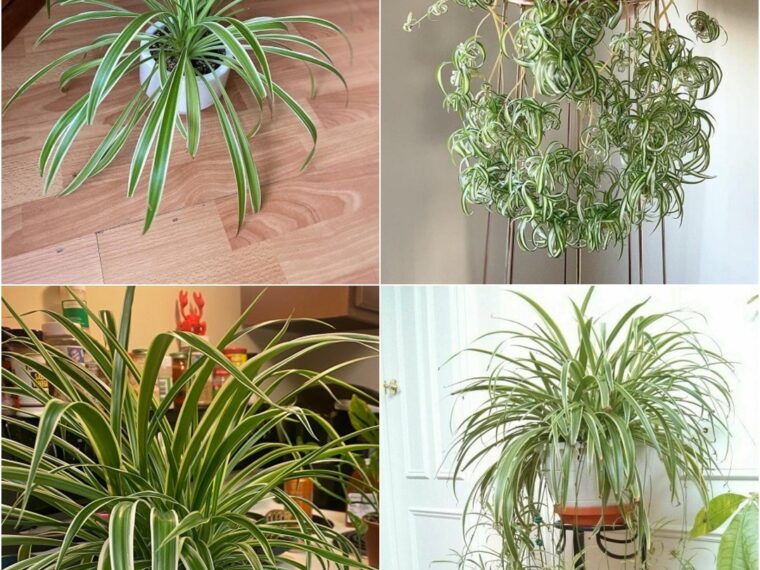Spider plants—also known by names like Ribbon plant, Airplane plant, St. Bernard’s lily, and spider ivy—are among the most beloved and popular houseplants worldwide. Their vibrant green foliage and graceful arching leaves instantly add life, texture, and color to any indoor space. Whether placed in decorative pots, hanging baskets, or containers, spider plants bring an irresistible charm to your home or office.
But their appeal goes far beyond their good looks. Thanks to their easy-care nature, pet-friendly qualities, and scientifically proven air-purifying powers, spider plants are a top choice for anyone wanting a healthier, more vibrant living environment.
Let’s dive deeper into why growing spider plants is a smart move for your home—especially if you want a natural way to boost air quality, improve health, and enjoy low-maintenance greenery.
1. A Low-Maintenance Wonder
One of the most remarkable things about spider plants is how forgiving and adaptable they are. They truly thrive on neglect, making them perfect for beginners or busy plant owners who might forget to water regularly.
Spider plants tolerate a wide range of growing conditions. While they prefer bright, indirect sunlight, they also flourish in low light or partial shade areas. They’re equally unbothered by occasional overwatering or underwatering, so you don’t need to stress about keeping the perfect moisture balance.
These resilient qualities mean that whether you’re a seasoned gardener or just starting, the spider plant is a fantastic, worry-free choice for your indoor garden.
2. Breathe Easier: Improve Respiratory Health
Indoor air quality directly impacts respiratory health, and spider plants are champions at improving it. They absorb carbon dioxide and release oxygen, just like other plants, but they’re especially efficient due to their high chlorophyll content.
Spider plants produce more chlorophyll than many other common houseplants, meaning they generate more oxygen, helping you breathe fresher air indoors. This natural oxygen boost can be especially beneficial in tightly sealed homes or office spaces where fresh air circulation is limited.
You can place spider plants both inside your home and outdoors on patios or balconies to enhance oxygen levels naturally, creating a more refreshing, healthier atmosphere.
3. Safe for Pets and People
For pet owners, choosing houseplants can be tricky—many popular indoor plants are toxic to cats, dogs, or other furry friends. The spider plant stands out as a safe, non-toxic option.
Its leaves contain no harmful substances, so if your curious pets nibble or play with the plant, you can rest easy knowing it won’t cause poisoning or adverse reactions.
This pet-safe quality, combined with the spider plant’s air-cleaning abilities, makes it a perfect addition for families with animals, ensuring everyone enjoys a safe, healthy environment.
4. Natural Absorber of Ozone and Nitrogen Dioxide
Indoor air pollution is a growing concern, with harmful gases like ozone and nitrogen dioxide seeping into our homes from outdoor pollution and household products.
Spider plants are proven absorbers of these pollutants. They effectively remove nitrogen dioxide—a toxic gas linked to respiratory issues and cardiovascular problems—from indoor air. They also absorb ozone, a common indoor pollutant that can cause headaches, throat irritation, and worsen asthma symptoms.
By filtering out these invisible dangers, spider plants help create a safer, cleaner breathing environment in your home or workplace.
5. Aid for Patients and Mental Health
Hospitals and care facilities have increasingly turned to indoor plants for their healing benefits, and spider plants have been part of this trend.
Studies have shown that having spider plants in hospital rooms helps patients recover faster after surgery. The presence of these plants has been associated with reductions in pain levels, lower systolic blood pressure, decreased anxiety, and less fatigue.
Even in office environments, spider plants can positively impact wellbeing by reducing stress and boosting mood. Their presence fosters a calming atmosphere, making them an excellent natural remedy for mental fatigue and tension.
6. Effective Air Pollutant Cleaners
Beyond ozone and nitrogen dioxide, spider plants have been scientifically shown to absorb other common indoor air toxins such as formaldehyde and benzene.
Formaldehyde is a volatile organic compound (VOC) found in household cleaning products, synthetic fabrics, and furniture off-gassing. Benzene, a carcinogen, often comes from tobacco smoke, paint fumes, and adhesives.
By removing these dangerous substances, spider plants significantly reduce indoor air pollution and improve overall air quality. This detoxifying effect helps lower the risk of respiratory diseases, allergic reactions, and general discomfort caused by poor indoor air.
7. Increase Indoor Humidity Naturally
Dry indoor air can cause discomfort—dry skin, irritated sinuses, and increased susceptibility to colds and flu. Spider plants naturally increase humidity by releasing moisture through transpiration.
This added humidity benefits both your respiratory system and skin, especially in winter months when indoor heating systems dry out the air. Higher humidity levels can also reduce the survival rate of airborne viruses and bacteria, creating a healthier environment for you and your family.
Bonus: Propagation and Aesthetic Appeal
Spider plants also stand out for their ease of propagation. They produce “spiderettes”—tiny baby plants that dangle from long stems—making it effortless to multiply your greenery and share plants with friends.
Aesthetically, the graceful arching leaves and lush green-and-white striped foliage add texture and freshness to any room. Whether in hanging baskets or tabletop pots, spider plants bring vibrancy and life to your décor.
Caring for Your Spider Plant
- Light: Prefers bright, indirect sunlight but tolerates low light. Avoid harsh direct sunlight which can scorch leaves.
- Water: Keep soil evenly moist but not soggy. Allow the top inch of soil to dry between watering.
- Temperature: Thrives in average indoor temperatures (60–75°F / 15–24°C).
- Humidity: Benefits from moderate humidity but adapts well to dry air.
- Fertilizer: Feed with a balanced liquid fertilizer once a month during growing seasons (spring and summer).
Final Thoughts
The spider plant is much more than just a pretty face in your living room. It’s a versatile, low-maintenance, and scientifically backed natural purifier that enhances your indoor environment and supports your wellbeing.
From clearing toxins and improving air quality to being safe for pets and helping reduce stress, the spider plant truly earns its spot as one of the best houseplants you can grow.
So if you’re looking to add a splash of green that’s both beautiful and beneficial, the spider plant is a must-have.





